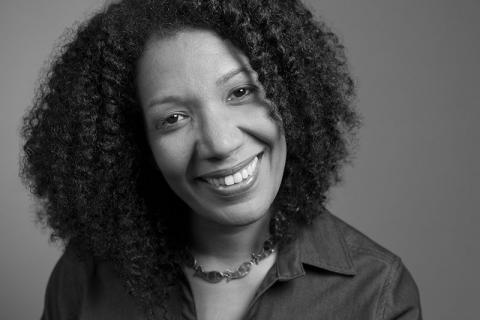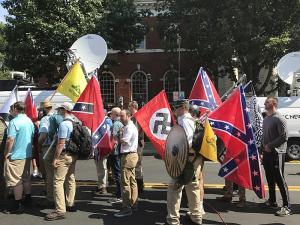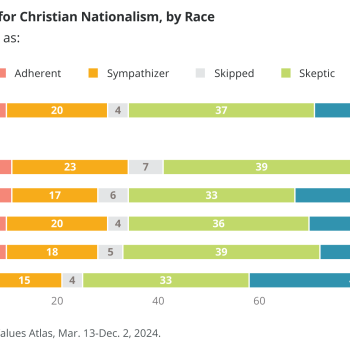
When Lisa Sharon Harper marched in Charlottesville to protest white nationalism, she felt fear. “It really felt like every step you take could be your last,” she said, later adding: “With each step, I just kept holding on to the call to love.”
Harper, along with Cornel West and dozens of other clergy, became a striking feature of the Charlottesville landscape on that bloody weekend. Garbed in multicolored robes and stoles, they kneeled and prayed and sang “This Little Light of Mind.” Arms linked, they offered a strong front of spiritual resistance in the midst of street fights between white supremacists and the Antifa.
Embed from Getty Images
As these clergy practiced nonviolent love—and a bit of fear and trembling—they did so with striking discipline. This discipline was grounded in methods used by the civil rights activists of the 1960s, but also notably in tactical training from Mennonites. Specifically, Christian Peacemaker Teams (CPT) arrived in Virginia weeks ahead to prepare protesters associated with Deep Abiding Love and Congregate Charlottesville in the ways of Christian nonviolence.
A little Mennonite history
CPT began in the 1980s at a key moment in Mennonite history. Having lived quietly in rural American settings for centuries, Mennonites were beginning to emerge out of their German and Russian ethnic enclaves. They began to dress less like the Amish, attend universities, and participate in mainstream American culture. Most maintained a commitment to peace, but it began to take different shape. A remarkable speech by Ron Sider at the 1984 World Mennonite Conference in Strasbourg, France, represented this more activist trajectory. Decrying “isolationist pacifism,” “passive nonresistance,” and the “isolationist pacifism of withdrawal,” he proposed a “third option.”

Sider, author of the celebrated and reviled Rich Christians in an Age of Hunger, said, “We can always prayerfully and nonviolently place ourselves between the weak and the oppressor. Do we have the courage to move from the back lines of isolationist pacifism to the front lines of nonviolent peacemaking?” Recovering a much older activist Anabaptist heritage from the Reformation, he ended with a flourish: “Unless we Mennonites and Brethren in Christ are ready to start to die by the thousands in dramatic vigorous new exploits for peace and justice, we should sadly confess that we really never meant what we said. We did, of course, in earlier times. In previous centuries, we died for our convictions. But today we have grown soft and comfortable. We cling to our affluence and our respectability. Making peace is as costly as waging war. Unless we are prepared to pay the cost of peacemaking, we have no right to claim the label or preach the message. Unless we are ready to die developing new nonviolent attempts to reduce conflict, we should confess that we never really meant that the cross was an alternative to the sword.”
Sider’s speech ended up launching Christian Peacemaker Teams, a “sophisticated, highly trained, nonviolent peace-keeping force,” that sought alternative approaches beyond violence and passive nonresistance. Since the 1980s teams have been dispatched on short notice to sites of conflict all over the world. They hold prayer vigils, document atrocities and violence during wars, and stage public protests. Following Sider’s suggestion, CPT’s “soldiers” have been prepared to “die by the thousands in dramatic vigorous new exploits for peace and justice.”
How Mennonite peacemaking played out in Charlottesville
In more recent years CPT has been summoned to sites in North America. Most recently religious leaders invited CPT leaders to train activists in advance of the “Unite the Right” rally in Charlottesville. Indeed, the clergy response to the violence reflected many elements of contemporary Mennonite peacemaking techniques.

First, peacemaking requires courageous action in the face of evil. According to one report, neo-Nazi militia members verbally assaulted the clergy with insults, calling them “weak” and shouting “You really believe that?” in their faces as they sang. “We got a lot of vitriolic slurs,” said one protestor. “Most of them homophobic.” As tension ratcheted up on Saturday, a group of the trained clergy formed a line across the entrance of the park and linked arms, blocking white supremacists with shields from entering. They believed that there is a time for confronting evil, not just standing passively by from a distance. As Sider suggested thirty years ago, what if Christians were as willing to train and die for peace as they are for war? Pacifism is not the same as passivism.
Second, peacemaking requires the use of specialized techniques. CPT, used to dealing with multiple armed actors in close space, trained clergy in Charlottesville how to protest in an open-carry state. They learned how to engage white supremacists with a calming presence, to practice discipline in the midst of chaos, to lock arms in the midst of chaos, to roll to the right to preserved the liver if kicked, to lower their heads and shout “medic” in the case of tear gas, to offer medical care, and to use their powers of observation to make adjustments. In fact, only the 80 clergy who had been trained in nonviolent resistance were permitted by organizers to march directly into the heart of the action. A group of latecomers was relegated to a rally a block away.
These techniques worked. After the car plowed through a group of protestors, clergy sprinted into the chaos before police or ambulances arrived. They helped the wounded and offered a calming presence to the suffering. Trained to deescalate conflict, they stopped fights. According to Brian McLaren, “Sometimes our presence, just by a bunch of clergy showing up … people who were angry or looking for a fight would calm down.”
Third, peacemaking requires a strong faith. Trainers, said Harper, made clear to protestors that “if we walk on the street, we could die.” CPT director Sarah Thompson, who did much of the training, explained, “We believe in the power of resurrection, so we need to not have fear of death. Bring to the communities that are so impacted by this the message to not be afraid.” In the face of sin, oppression, and death, says Thompson, spiritual resources offer “a peace that passes understanding.”
Fourth, peacemaking requires loving your enemy. Saying no to racists is not enough, even when they’re wearing “long guns, extra ammo, pistols at the hip, hatchets hanging from belt loops and dressed head to toe in camouflage.” The ultimate goal is to show the enemy the transforming love of God. As Mennonite pastor Hillary Watson recently wrote, “We have to peel back the violent and abusive parts of white supremacy until we find what the scared humans underneath are digging for: reassurance that they won’t be left behind; that they have an economic future; that rural America still has value; that they can love Christmas without hating Hanukkah; that the places they come from are distinct and beautiful and the geography of them can be cared for without drawing boundaries on who is allowed in that geography.” Peacemakers must do the hard work of building “exit-ramps from white supremacy” for even the most unlovable.
Militia members were told by their leaders not to speak to protestors. But Harper, a black woman, wore down one white supremacist with words of love. As violence all around began to end their conversation, Harper told him, “I just want you to know, we love you.” The man’s face, grizzled and tired from the day, suddenly softened. After a moment, he replied: “I love you, too.”













